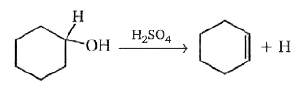Finkelstein reaction.
Step-by-Step Solution for Finkelstein Reaction
1. Understanding the Finkelstein Reaction:
The Finkelstein reaction is a halogen exchange reaction where an alkyl halide (typically a chloride or bromide) is converted into a higher halide (iodide) using sodium iodide (NaI) in a polar aprotic solvent like acetone.
2. Starting Materials:
- You need an alkyl halide (R-Cl or R-Br).
- Sodium iodide (NaI) as the iodide source.
- Acetone as the solvent.
3. Reaction Mechanism:
- The alkyl halide (R-X, where X is Cl or Br) reacts with sodium iodide (NaI).
- The iodide ion (I⁻) from NaI attacks the carbon atom of the alkyl halide, leading to the displacement of the lower halogen (Cl or Br).
- This results in the formation of an alkyl iodide (R-I) and the release of sodium halide (NaX, where X is Cl or Br).
4. Product Formation:
- The final product of the reaction is the alkyl iodide (R-I).
- The by-product is sodium halide (NaX), which can be sodium chloride (NaCl) or sodium bromide (NaBr) depending on the starting material.
5. Reaction Conditions:
- The reaction is typically carried out in acetone, which is a polar aprotic solvent that helps in solubilizing the reactants and facilitating the nucleophilic substitution.
Summary of the Finkelstein Reaction:
- Starting Material: Alkyl halide (R-Cl or R-Br)
- Reagent: Sodium iodide (NaI)
- Solvent: Acetone
- Product: Alkyl iodide (R-I)
- By-product: Sodium halide (NaX)
The Finkelstein reaction is a halogen exchange reaction where an alkyl halide (typically a chloride or bromide) is converted into a higher halide (iodide) using sodium iodide (NaI) in a polar aprotic solvent like acetone.
- You need an alkyl halide (R-Cl or R-Br).
- Sodium iodide (NaI) as the iodide source.
- Acetone as the solvent.
- The alkyl halide (R-X, where X is Cl or Br) reacts with sodium iodide (NaI).
- The iodide ion (I⁻) from NaI attacks the carbon atom of the alkyl halide, leading to the displacement of the lower halogen (Cl or Br).
- This results in the formation of an alkyl iodide (R-I) and the release of sodium halide (NaX, where X is Cl or Br).
- The final product of the reaction is the alkyl iodide (R-I).
- The by-product is sodium halide (NaX), which can be sodium chloride (NaCl) or sodium bromide (NaBr) depending on the starting material.
- The reaction is typically carried out in acetone, which is a polar aprotic solvent that helps in solubilizing the reactants and facilitating the nucleophilic substitution.
- Starting Material: Alkyl halide (R-Cl or R-Br)
- Reagent: Sodium iodide (NaI)
- Solvent: Acetone
- Product: Alkyl iodide (R-I)
- By-product: Sodium halide (NaX)
Topper's Solved these Questions
Similar Questions
Knowledge Check
Which of the following reaction is an elimination reaction ?
A B
B C
C Dboth (a) and (b)
Dboth (a) and (b)
Why are decomposition reactions called the opposite of combination reactions? Write equations for these reactions.
View SolutionDifferenctiate between,- a. Direct combination reaction & a decomposition reaction b. Displacement reaction & a neutralization reaction.
View SolutionWhich of the following reactions are disproportionation reaction ?
View SolutionWhich of the following reactions is not a disproportination reaction ?
View SolutionWhat is Combination reaction ? Explain with the help of chemical reaction .
View SolutionLife threatening reaction caused by severe allergic reactions
View SolutionThe disproportionation reaction (s) among the following reactions is /are
View Solution
